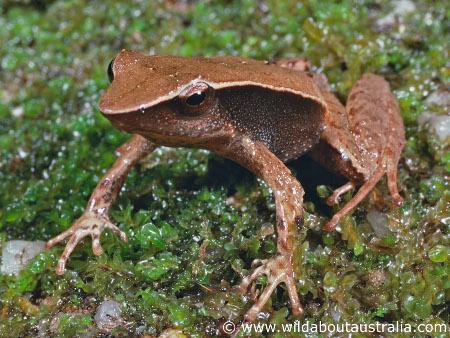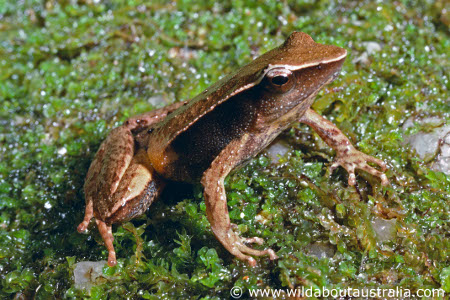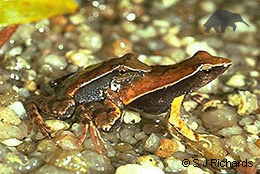
With only three individuals reported since 1994, it is possible that the sharp-snouted day frog (Taudactylus acutirostris) is already extinct. This frog was the first species in which the fungus Batrachochytrium dendrobatidis was identified, which causes the devastating ‘frog-killing’ disease chytridiomycosis.
The sharp-snouted day frog belongs to the Myobatrachidae family, which arose around 100 million years ago when dinosaurs dominated life on Earth. The family is unique among amphibian groups because most of the members show a degree of parental care, for example carrying tadpoles in their mouths and pouches. Its genus Taudactylus (also known as torrent frogs) contains just six species, and is highly threatened with extinction, as most are either extinct or highly endangered.
The sharp-snouted day frog has the most distinctive features of its genus. It is a small frog with a narrow wedge-shaped nose that is acutely pointed and protrudes well over the bottom jaw, and sometimes it has dark V- or W-shaped markings on its back. The day frog can breed all year round, and females usually lay up to 40 large eggs near streams. After they are hatched, tadpoles spend most of their time in slow flowing water. Male day frogs have two types of call: one like a metallic tinkling and the other more like a chirp, probably used depending on whether they intend to mate or defend their territory.
 The sharp-snouted day frog is generally found among rocks and leaf litter along the edges of fast-flowing rainforest streams; although in wet weather they can venture further from water. They are most active during the day and have actually been seen basking in the sun.
The sharp-snouted day frog is generally found among rocks and leaf litter along the edges of fast-flowing rainforest streams; although in wet weather they can venture further from water. They are most active during the day and have actually been seen basking in the sun.
The species is endemic to Australia, and suffered a dramatic decline in the late 1980s from its range in northern Queensland, most likely because of chytridiomycosis: in 1993 post-mortem examinations revealed infection with this fungus, but at the time it was not linked to any serious effects in frogs. The last few sightings of the day frogs were 30km south of Cooktown in 1995, in the South Johnstone River in 1996, and finally near Mount Hartley in 1997. All recent surveys have failed to locate any individuals. The sharp-snouted day frog is still currently classified as Critically Endangered (IUCN, 2007), and along with habitat loss and restricted range the total population size is estimated to be less than 250 mature individuals. Conservationists worldwide now fear that this frog is extinct.

If this species is still surviving it is likely to be in small, highly fragmented populations. National parks cover a lot of the sharp-snouted day frog’s habitat but none of these can protect it from the chytrid fungus. Even a captive rearing programme succumbed; Melbourne Zoo and the Queensland Department of the Environment raised tadpoles to metamorphosis but all individuals ended up infected.
If any further surveys are undertaken and sharp-snouted day frogs are found, translocation of the populations or individuals to captivity or a chytrid – free environment may be the only way to save them.
Have your say: do you think we should be investing conservation resources in species we think are likely to be extinct? Start a discussion in our forum…